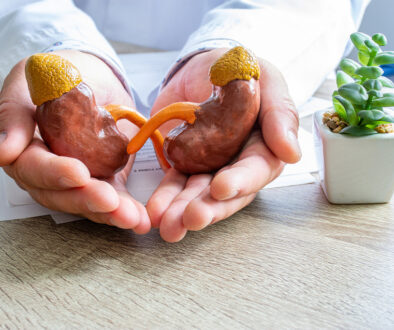Can Fatty Liver Disease Be Reversed? 7 Vital Facts
In this article:
So you skipped the gym this week. No big deal, you may think. Or perhaps you even overindulged in too much pizza and alcohol while watching the basketball game. No worries, you tell yourself.
But what you don’t realize is that all these “little” incidents can add up to create a big problem. Fatty liver disease is on the rise, and most Americans aren’t even aware that they have it. The disease typically doesn’t show any symptoms until it’s advanced.
Unchecked, it can lead to extensive liver scarring and, eventually, cirrhosis. Cirrhosis is a serious disease caused by liver damage. Cirrhosis cannot be cured, only managed. In severe cases, a liver transplant may be needed.
With so much hanging in the balance, how do you discover you have fatty liver, and even more important, if you have it, can fatty liver disease be reversed?
Diseases like fatty liver disease are usually first detected in routine blood work, like the kind we conduct at Raleigh Medical Group.
For nearly 50 years, we’ve helped area residents live healthier lives. Our patient centered care has earned many accolades, and we’re the premier internal medicine physicians in Raleigh. If it’s been a while since you’ve had a physical, or if you’re past due for one, we encourage you to schedule an appointment with us.
We’ll examine what fatty liver is and if fatty liver is reversible by exploring 7 vital facts you need to know to help safeguard your health.
Can Fatty Liver Disease Be Reversed? 7 Vital Facts
By some estimates, advanced cases of fatty liver disease will quickly become the leading cause for liver transplantation in the United States and in the world, according to information from the National Library of Medicine.
But the good news is that fatty liver can be reversed if it is caught in the earliest stages, and we’ll take you through the facts you need to know about this disease so you can understand how to take charge of your health.
1. Fatty liver disease is caused by excessive fat buildup in the liver.
When your liver is overwhelmed by fat–comprising more than 5 to 10 percent of the liver’s weight– you have fatty liver disease. This disease affects an estimated 25 percent of Americans, according to the American Liver Foundation.
If not corrected, the fat will continue to build up, increasing the risk of developing a more serious form of fatty liver disease called NASH (nonalcoholic steatohepatitis). In NASH, the liver swells and becomes damaged.
2. There are two types of fatty liver disease: non-alcoholic vs. alcohol-related
The liver is vital for processing food and removing toxins from the blood. Excessive alcohol use can make it more difficult for the liver to do its job, reducing its ability to heal. This is usually seen after long periods of alcohol misuse. If fatty liver is not caused by alcohol, it’s referred to as non-alcoholic fatty liver disease.
3. Reducing alcohol intake can help reverse fatty liver disease.
If your fatty liver is caused by excessive alcohol use, then it is vital that you stop drinking. This will prevent your liver disease from getting worse. The good news is that after abstaining from alcohol for months or years, the fatty liver may begin to reverse. However, only your internal medicine physician in Raleigh can determine if the disease has changed course.
If you have fatty liver that is not caused by alcohol, it’s still a good idea to avoid drinking or do so only rarely. Again, we’ll work with you to determine the best course of action.
4. Regular exercise can help reduce fatty liver disease.
Studies indicate that a combination of both aerobic and resistance training exercises can not only help reduce the fat in your liver, but they can also help lower cholesterol and help correct insulin resistance.
We encourage you to have a regular exercise routine, and we’re glad to help you come up with the most effective plan to increase your chances of reducing fatty liver disease.

5. Eating a healthy diet is crucial if you want to reverse fatty liver disease
Can fatty liver be reversed? The first step is to ensure you’re eating a healthy diet, one low in saturated fats and fried foods. Remember that your liver processes what you eat, filters toxins from your system and assists your body in digestion.
If you eat a high-fat meal, you’re asking your already fatty liver to do more “work.”
But eating healthier doesn’t mean sacrificing flavor. Our registered dietitian Nicole Matala has guided many patients through this journey, resulting in a healthier lifestyle that not only is better for their bodies, but also makes them feel better.
6. Maintaining a healthy weight can also help reverse fatty liver disease.
Do you know your BMI? This stands for Body Mass Index, and it’s a measurement that takes both your height and your weight into account to create a number that indicates if you are at a healthy weight or if you’re overweight. We encourage you to use this BMI calculator to find out where you stand.
Studies have shown that even a modest weight loss of 8 to 10% can make a big difference. That may seem overwhelming, but we’re with you every step of the way.
7. Regular physicals are vital to track your progress.
Often, the first sign that something is wrong with your liver is a blood test that shows elevated liver enzymes. This is an indication that your liver isn’t working as it should. Because fatty liver disease often doesn’t show any symptoms in its earliest stages, the only clue you have about your liver function is these tests.
Does Fatty Liver Disease Show Symptoms?
As we just mentioned, typically, it does not. However, when it does, the following symptoms can occur:
If your fatty liver disease is advancing, you could show possible symptoms of NASH (nonalcoholic steatohepatitis), a more serious version of fatty liver disease. Symptoms of NASH – and possibly cirrhosis or liver scarring include:
Can Fatty Liver Disease be reversed? Yes, with help from our Internal Medicine Physicians in Raleigh
Fatty liver is quickly becoming a major public health problem, with some estimates that it affects roughly 25% of the world population. In its early stages, it can be reversed, which is why it’s vital to work closely with our experts to correct the situation before it evolves into something more serious.
When was the last time you had regular blood work? That may be the only time you are aware of how your liver enzymes look. We encourage you to schedule an appointment with us so our internal medicine doctors can gain a better snapshot of your health.
Key Takeaways:
- Fatty liver disease is caused by too much fat in the liver. There are two versions: non-alcoholic and alcoholic.
- Fatty liver disease can be reversed if it’s in the earliest stages.
Steps to help reverse fatty liver include:- Getting regular exercise
- Eating a healthy diet
- Avoiding alcohol
- Maintaining a healthy weight
- If not properly managed, fatty liver can evolve into a more serious form called NASH or even progress to cirrhosis.




